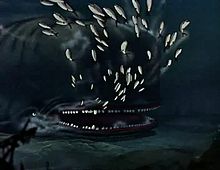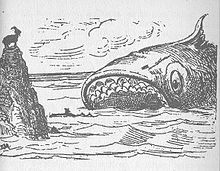- The Terrible Dogfish
-
- "Monstro" redirects here. For the Marvel Comics character that sometimes went by that name, see Giganto.
The Terrible Dogfish The Adventures of Pinocchio character First appearance The Adventures of Pinocchio Created by Carlo Collodi Information Species Shark Gender Male The Terrible Dogfish (Italian: Il Terribile Pescecane) is a fictional sea monster which appears in Carlo Collodi's book The Adventures of Pinocchio (Le avventure di Pinocchio). It is described as being larger than a five storey building, a kilometre long (not including the tail) and sporting a mouth with three rows of teeth that can easily accommodate a whole train. So fearsome is its reputation, that in chapter XXXIV, it is revealed that the Dogfish is nicknamed "The Atilla of fish and fishermen" (L'Atilla dei pesci e dei pescatori).
Contents
Role
The Dogfish is first mentioned in chapter XXIV, when Pinocchio, whilst searching for his creator Mister Geppetto, is informed by a dolphin that he has likely been swallowed by the creature which "...for some days has come to wreak extermination and desolation in our waters". The Dogfish is later mentioned in chapter XXVI by Pinocchio's school friends on the Island of the Busy Bees (Isola delle Api Industriose), who tell him that the creature has been sighted on the coast and that they are going to investigate. This later turns out to be a lie to coax Pinocchio away from school.
The Dogfish makes its first appearance in chapter XXXIV when Pinocchio, who has only just transformed from a donkey back to his puppet form, has entered the sea in an attempt to escape from his former handler. The Fairy with Turquoise Hair, in the form of a mountain goat, warns Pinocchio of the Dogfish too late, and the puppet is swallowed whole, along with a tuna whom Pinocchio befriends. Pinocchio discovers his father, who reveals that he has been trapped within the Dogfish for two years, surviving on ship supplies swallowed by the creature. The Dogfish is revealed to suffer from asthma, and sleeps with its head emerged from the water. Pinocchio carries Geppetto, who cannot swim, on his back and swims out of the Dogfish's mouth. When Pinocchio's strength begins to fail him, the tuna whom Pinocchio befriended before, helps them reach the shore.
In Disney Version
 "Monstro", as portrayed in Pinocchio (1940)
"Monstro", as portrayed in Pinocchio (1940)
In the Disney film Pinocchio, the sea monster (which is named Monstro, the Portuguese word for monster) is portrayed as a sperm whale rather than a great white shark, who is first mentioned when Pinocchio and Jiminy Cricket receive a message from the Blue Fairy stating that Geppetto, while venturing out towards Pleasure Island to find Pinocchio, has been swallowed by the creature. The two go in search of the monster, but are frustrated in their efforts by the fear the ocean denizens display every time they mention it. They find the whale but, before they can swim away, Monstro swallows Pinocchio. Pinocchio finds Geppetto and his pets within Monstro, prompting both "father" and "son" to find a way to escape. Pinocchio frees them by starting a fire which causes the whale to sneeze them out. Monstro becomes enraged and furiously chases them, but fails and smashes into a giant cliff under which Pinocchio, dragging the unconscious Geppetto with him, escapes but at the apparent cost of his own life. Monstro's final fate is left unrevealed. Monstro was animated by Wolfgang Reitherman, the go-to man for action sequences among Disney's Nine Old Men.
In Kingdom Hearts
The Disney version of Monstro also appears in the video game Kingdom Hearts as a supporting world, where Pinocchio and Geppetto temporarily live until being rescued. Within Monstro dwell many Heartless, including one called the Parasite Cage, which eats Pinocchio, trapping him within its cage-like stomach, and delivers the puppet to Riku, who wishes to use Pinocchio's heart to rescue Kairi. After Kingdom Hearts is sealed, Monstro presumably returns to his world. He later reappears in Kingdom Hearts: Chain of Memories, as a figment of Sora and Riku's memories. Monstro himself is not physically seen, but card rooms resembling his bowels are explored. In the Final Mix version of Kingdom Hearts: Birth by Sleep, Monstro appears as a boss fight in the Mirage Arena.
In Bonkers (TV series)
In addition, Monstro had a guest star appearance in a Bonkers comic story titled "Whale of a Tale", published in the December 1994 issue of Disney Adventures. In this story, he is not villainous, but rather a polite actor who was simply playing a role in Pinocchio and had not found work in the movies since then; he is duped by a gang of crooks, posing as a movie company, into breaking into banks for them to rob, and upon finding out the truth, helps Bonkers catch the criminals.
In Fantasmic
The Whale also plays a notable role in the Disneyland version of Fantasmic!, and also has a smaller role in the Dancing Bubbles scene in the Disney's Hollywood Studios version.
Portrayals in other media
- In Giuliano Cencis 1972 adaptation Un burattino di nome Pinocchio, the Terrible Dogfish is portrayed very similarly to that of the book, the only difference being that it is not mentioned before its initial appearance.
- In Steve Barrons 1996 live action film The Adventures of Pinocchio, the Terrible Dogfish (referred to only as "the sea monster") is shown to be Mangiafuoco, who is named "Lorenzini" in the movie and played by Udo Kier, transformed after drinking the cursed water which turned children into donkeys. In the final act of the movie, Lorenzini-whale shallows Geppetto (who went to sea to find his son) and later Pinocchio. In his belly, Pinocchio finally riunite with Geppetto and they both menage to escape from Lorenzini's womb by climbing his throat. For making pass his father through, Pinocchio starts saying lies causing his nose to grow, stabbing Lornzini's throat. Lorenzini dramatically coughs Pinocchio and Geppetto out, before succumb in the deeps of the sea.
References
- Collodi, Le Avventure di Pinocchio 1883, Biblioteca Universale Rizzoli
Characters Pinocchio · Candlewick · The Coachman · The Fairy with Turquoise Hair · Figaro · The Fox and the Cat · Mister Geppetto · The Green Fisherman · Mangiafuoco · Talking Cricket (Jiminy Cricket) · The Terrible DogfishFilms The Adventures of Pinocchio (1936) · Disney's Pinocchio (1940) · The Adventures of Buratino (1959) · Pinocchio in Outer Space (1965) · Pinocchio (1968) · Pinocchio (1972) · The Adventures of Buratino (1975) · Pinocchio and the Emperor of the Night (1987) · Pinocchio (1993) · Pinocchio's Revenge (1996) · The Adventures of Pinocchio (1996) · Geppetto (2000) · A.I. Artificial Intelligence (2001) · A Tree of Palme (2002) · Pinocchio (2002) · Pinocchio 3000 (2004) · Pistachio – The Little Boy That Woodn't (2010)Television Pinocchio (musical) · The New Adventures of Pinocchio (1960 TV program) · Mokku of the Oak Tree (1972 anime series) · Piccolino no Bōken (1976 anime series) · Pinocchio's Christmas (TV special)Other media The Golden Key, or the Adventures of Buratino (novel) · Pinocchio's Daring Journey (attraction) · The Adventures of Pinocchio (video game) · Pinocchio (Fables comics) · The Adventures of Pinocchio (opera)Disney songs Related Categories:- Pinocchio characters
- Kingdom Hearts characters
- Fictional cetaceans
- Fictional fish
- Fictional characters introduced in 1883
Wikimedia Foundation. 2010.

